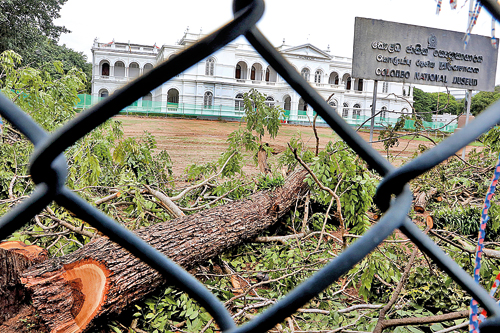When big trees fall

Destruction at the museum seen last week. Pic by M.A. Pushpa Kumara
With great sadness I record two recent events that have befallen us. One more personal than the other, but they are interrelated. The first was the sorrowful event of the passing of Dr Siran Deraniyagala, a former Head of the Department of Archaeology. A scholar who was widely recognized for his research and publications on prehistory, archaeology, paleoanthropology and paleoecology, Siran died after a brief illness at his residence in Kuruwita, near Ratnapura.
He had a wide range of interests and was particularly attentive to his surroundings, both at his home in Kuruwita and his office at the Department of Archaeology on Sir Marcus Fernando Mawatha (formerly Edinburgh Crescent), Colombo where he worked for almost four decades.
In the early 2000s, the Colombo Municipality attempted to fell the large, mature trees along the wall that forms the museum’s boundary on Sir Marcus Fernando Mawatha to make way for a dual highway that would link this road to Alexandra Place. The first few branches were already shorn off the trunks and in a panic I approached Siran with an appeal to stop the destruction. I did not have much hope that he could do much to forestall the disaster. I remember that it was a weekend and he was back in Kuruwita.
But Siran responded swiftly: in his official capacity as Director of Archaeology he issued a letter addressed to the Mayor of the Colombo Municipality. In it he explained that these trees, which were more than 150 years old, were an important national heritage and that their removal was a prosecutable offence.
At the same time, he informed the then President Chandrika Kumaratunga, and alerted the National Museum authorities, who thanks to Siran’s intervention, responded positively. The Municipal team tasked with cutting the tree abandoned their task and these magnificent trees were saved. In effect, Siran’s efforts single-handedly saved some of the oldest and largest trees in the centre of Colombo.
The second sad development that has occurred over recent weeks is the ruthless felling of the trees bordering the boundary wall of the museum on Sir Marcus Fernando Mawatha. Among these mature trees were Mango (Mangifera Indica), Margosa (Azdirachta Indica), Ehela (Cassia fistula), Ruk Athana (Alstonia scholaris) and the Indian Cork tree (Millingtonia hortensis). A majority of these trees would have been planted almost 75 years ago, and many of them have been flowering and fruiting for several decades.
Those responsible for the felling of these trees do not appreciate the important environmental function served by the vegetation in and around the museum property. The felled trees were an effective barrier against the vast amount of dust thrown up by the traffic on Sir Marcus Fernando Mawatha and also served as a buffer to reduce the sound emanating from the myriad of buses, trucks, cars and motorcycles that ply this road. The trees in the museum property have also served as a refuge for birds and butterflies, providing sustenance for a variety of species. Among the birds that have been recorded from the museum premises are the Barn Owl, Indian Roller and the migratory Blue tailed Bee eater. The trees also provided shade for the numerous commuters and pedestrians. In a city lacking large parks, it is trees bordering roadsides and within and around properties that help keep Colombo cool, clean and oxygenated.
During the most recent lockdown, the National Museum appears to have been engaged in a project to uproot the existing lawn. As to why this has been prioritized when there are far more urgent needs is unclear. An extensive portion of the museum’s roof is damaged and leaking, and urgently needs maintenance and repair. Many of the storage cupboards and exhibition stands are old and require modern fittings or have to be replaced. The museum’s extensive, historically valuable and irreplaceable collections require better protection, with the installation of a comprehensive surveillance and burglar alarm system being vital.
At the present time, the last thing the National Museum needs is extensive concrete paving, which would not only increase the glare but will also increase levels of heat and dust in and around the museum premises.
As I understand it, the trees that have been felled were closely associated with Siran’s father, Paul Deraniyagala, who was Director of the National Museum from 1939–1963. Although the finances available to the National Museum were dismally inadequate, Dr Deraniyagala tried to maintain the museum’s extensive gardens and enhance the surrounding landscape. He is reputed to have initiated the planting of the avenue of trees along the museum’s boundary wall. A prolific researcher whose interests ranged from paleontology and zoology to cultural history, he almost single-handedly raised the profile of this institution through his scientific publications, much of which was published in the museum’s journal Spolia Zeylanica, of which he was the Editor-in-chief for a number of years.
The legacy left by Paul Deraniyagala and his son Siran are a testament to the enormous contribution that key government personnel have made over the years to the country.


